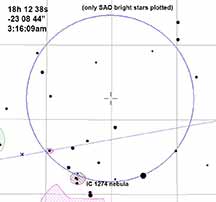

This event is by a G=15.3 asteroid, of a G=15.3 star, but in R the Star is 13.6 and the asteroid is likely brighter as well. The drop in magnitude will likely be more like 1.0 magnitude. Duration is 3.2 seconds, allowing long integration and still get a reliable positive. Alt=28, Az=196 in SSW, in crowded Sagittarius star field. Note the C2A charts has a spurious line of stars. I don't know what that's about, but take care in ID'ing the star field. I'd ignore that line of stars.
 |
 |
Karl was outside the path, and target just too faint for his gear. Kirk was clouded out at the Bonny Doon airport, I was amazed to see the fog had cleared when I got up at 2:30am, and scrambled to get set up on Rincon St near the mailboxes.
I observed from Rincon St just north of the driveway. The sky still had a lot of moisture and high clouds, and transparency at 28 degrees wasn't ideal. The target ended up being far closer to the neighbor's juniper tree than my GoogleEarth planning indicated. But, it did manage to avoid going into the tree during the event, and cloud cover was there, but not fatal. I used Spica and Altair as my 2-point align stars; not as far apart in the sky as I'd like, but the GoTo went bang-on to the target, sparing the angst I worried about. But I needed to crank up the integration to 32x before I could consistently see the star frame to frame. The seeing was terrible... blurry dancing blobs. I ended up at 32x which is about 0.6s but that's still enough if the odds are for a 3.2s event; that's 5 points in the shadow, enough to verify through the FP test.
magDrop report: percentDrop: 63.5 magDrop: 1.095 +/- 0.446 (0.95 ci)
DNR: 2.45
D time: [10:16:06.7947]
D: 0.6800 containment intervals: {+/- 0.2672} seconds
D: 0.9500 containment intervals: {+/- 0.7911} seconds
D: 0.9973 containment intervals: {+/- 2.0622} seconds
R time: [10:16:10.7212]
R: 0.6800 containment intervals: {+/- 0.2672} seconds
R: 0.9500 containment intervals: {+/- 0.7911} seconds
R: 0.9973 containment intervals: {+/- 2.0622} seconds
Duration (R - D): 3.9265 seconds
Duration: 0.6800 containment intervals: {+/- 0.4197} seconds
Duration: 0.9500 containment intervals: {+/- 1.1062} seconds
Duration: 0.9973 containment intervals: {+/- 2.3762} seconds
The light curve is a little strange; it should show a partial fall and flat for 8 integrations if it's really 3.9 sec long. Instead, it looks gradual and zero level at the bottom. It could be that the noise just happens to make the points are within noise levels of the predicted 1 magnitude drop square wave. Anyway, it satisfies the FP test at the 5-sigma level.
 |
 |
 |
 |
 |
 |